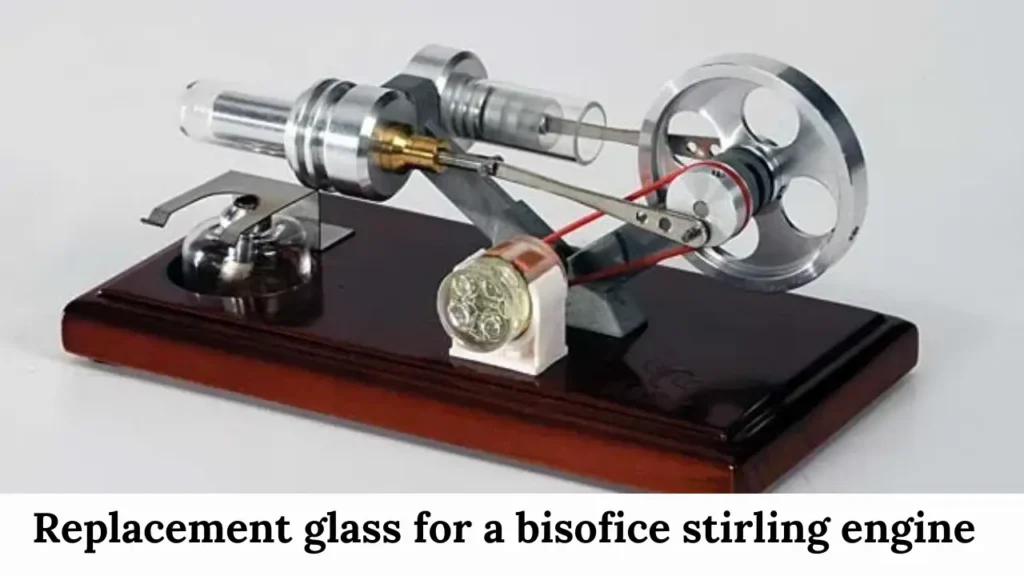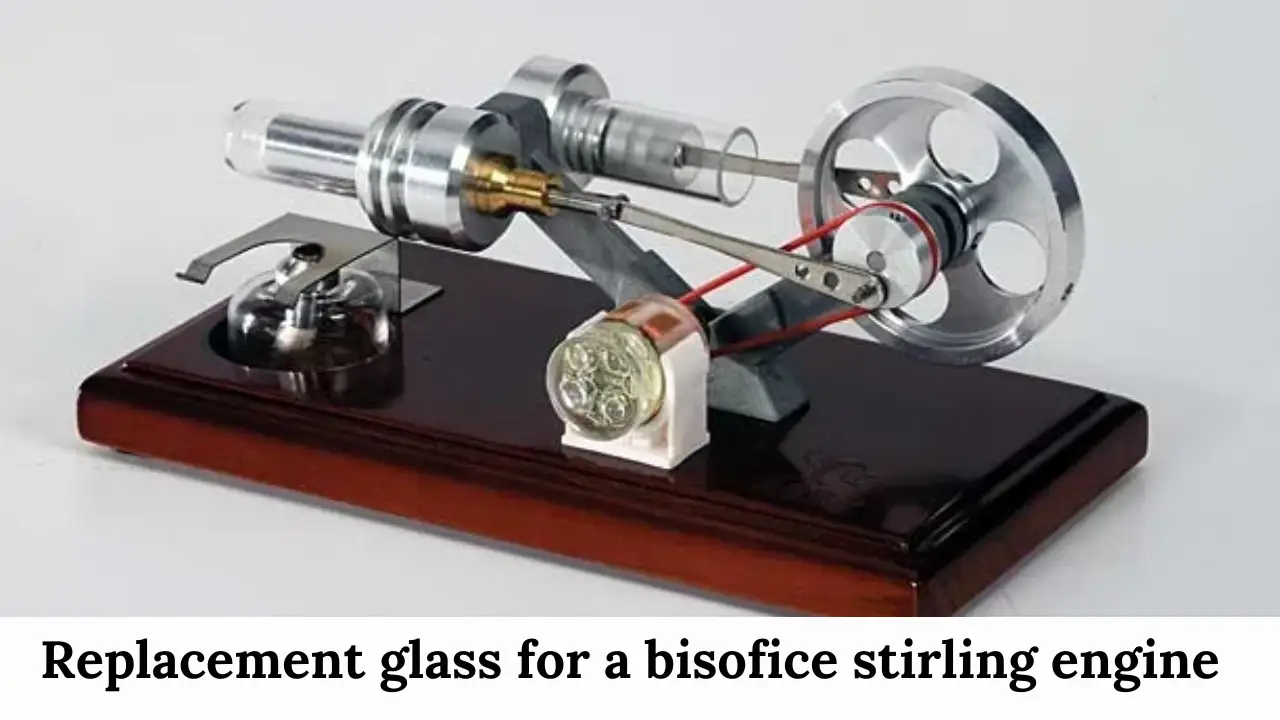
Replacement Glass for a BisoFice Stirling Engine, The Stirling engine is an external combustion engine that converts heat energy into mechanical work using cyclic compression and expansion of gas. The BisoFice Stirling engine is a popular variant, widely used for educational demonstrations and hobby projects due to its simple, yet visually engaging design.
One key feature of many BisoFice Stirling engines is the use of glass components, such as the displacer chamber or cylinder. However, these glass parts are prone to damage due to thermal stress or accidental mishandling, making replacement glass for a BisoFice Stirling engine a common necessity.
The Role of Glass in a BisoFice Stirling Engine
In a BisoFice Stirling engine, glass is typically used for the displacer chamber or cylinder. This transparent material allows users to observe the inner workings of the engine as it converts heat into mechanical motion. The use of glass in these engines serves several important purposes:
Transparency: Glass components provide a clear view of the engine’s moving parts, making it ideal for educational use, as students can directly see how the thermodynamic cycles work.
Heat Resistance: Borosilicate or quartz glass, commonly used in these engines, offers high thermal resistance, allowing the glass to withstand the extreme temperature changes generated during operation.
Low Friction: The smooth surface of glass minimizes friction, enabling efficient movement of the piston and displacer.
Due to its exposure to high temperatures and mechanical forces, the glass in a BisoFice Stirling engine is vulnerable to cracking or breaking, necessitating a replacement glass.
Why Replacement Glass is Necessary for a BisoFice Stirling Engine
There are several reasons why you may need to find replacement glass for a BisoFice Stirling engine:
- Thermal Stress: The engine operates by creating a temperature difference between the hot and cold sides. The hot side can reach temperatures up to 500°C (932°F), while the cold side remains at ambient temperature. This significant temperature differential can cause glass components to crack or break over time.
- Accidental Damage: Glass is fragile, and mishandling or accidental impacts during transportation or operation can lead to breakage.
- Wear and Tear: Repeated heating and cooling cycles weaken the structural integrity of the glass, eventually necessitating replacement to maintain optimal performance.
Choosing the Right Replacement Glass for a BisoFice Stirling Engine
Selecting the appropriate replacement glass for a BisoFice Stirling engine is critical to ensure the engine continues to operate efficiently and safely. The most common glass types used in Stirling engines are:
Borosilicate Glass:
- Borosilicate glass is the standard choice for most Stirling engines due to its excellent thermal shock resistance and durability. It can withstand temperatures up to 500°C (932°F), making it ideal for engines used in classrooms or for hobby purposes. Borosilicate is also affordable and readily available, making it the go-to material for replacement glass.
Quartz Glass:
- For more advanced models or applications where higher temperatures are involved, quartz glass may be used. Quartz can endure temperatures up to 1,200°C (2,192°F) and offers superior thermal resistance compared to borosilicate glass. However, quartz glass is more expensive, often costing two to three times more than borosilicate, but it’s a worthy investment for high-performance engines.
In most cases, borosilicate glass is sufficient for replacing broken or damaged parts in a BisoFice Stirling engine. However, if the engine operates at higher temperatures or requires additional durability, quartz glass is an excellent alternative.
Factors to Consider When Selecting Replacement Glass
When selecting replacement glass for a BisoFice Stirling engine, it is important to consider the following factors:
Fit and Dimensions: The replacement glass must match the original part’s dimensions exactly. Even slight deviations can lead to air leaks or reduced efficiency in the engine’s performance. Precision fitting is essential for maintaining the engine’s airtight seal.
Thermal Resistance: Depending on the operating conditions of your Stirling engine, you should choose glass with the appropriate thermal resistance. Most hobbyist engines will function well with borosilicate glass, but for high-temperature models, quartz glass may be necessary.
Cost: Borosilicate glass is generally affordable, costing around $5 to $10 for a small replacement cylinder. Quartz glass, on the other hand, can cost between $20 to $50 or more. Weighing the cost against the engine’s performance needs will help you choose the right option.
Where to Find Replacement Glass for a BisoFice Stirling Engine
Finding high-quality replacement glass for a BisoFice Stirling engine is critical to keeping your engine in working condition. There are several sources where you can find appropriate glass parts:
- Manufacturer or Distributor: The easiest and most reliable way to source exact-fit glass is to contact the manufacturer directly or purchase from an authorized distributor. These parts are guaranteed to fit and meet the engine’s design specifications.
- Specialty Glass Suppliers: If you need custom-made glass or higher-grade materials like quartz, specialty glass suppliers can provide tailored parts. These companies often cater to scientific glassware needs and can create glass components to your specific requirements.
- Online Marketplaces: Websites such as Amazon, eBay, and hobbyist forums often sell replacement parts for Stirling engines. While these may be cheaper, it’s important to verify the material and dimensions to ensure compatibility with your engine.
Steps to Replace Glass in a BisoFice Stirling Engine
Replacing the glass in a BisoFice Stirling engine requires careful handling to avoid damaging the new part. Follow these steps:
- Disassemble the Engine: Carefully remove the damaged glass by unscrewing or unfastening any retaining parts. Be gentle to avoid damaging surrounding components.
- Clean the Fitting Area: Ensure that the area where the new glass will be seated is free from debris, dust, or old adhesive. A clean surface is essential for a proper seal.
- Install the New Glass: Gently place the replacement glass into position, ensuring it fits snugly and securely. Check for any gaps that could lead to air leaks.
- Reassemble and Test: Reassemble the engine and perform a test run to ensure the new glass is properly installed and the engine operates smoothly.
Conclusion
The replacement glass for a BisoFice Stirling engine plays a critical role in maintaining the functionality and visual appeal of the engine. Whether due to thermal stress, accidental damage, or wear and tear, replacing glass components is often necessary to keep the engine in optimal condition.
Choosing the right material—whether borosilicate or quartz—and sourcing it from reliable suppliers ensures that your engine continues to perform efficiently.
By following the appropriate steps for installation, you can replace the glass safely and keep your BisoFice Stirling engine running smoothly for years to come.


